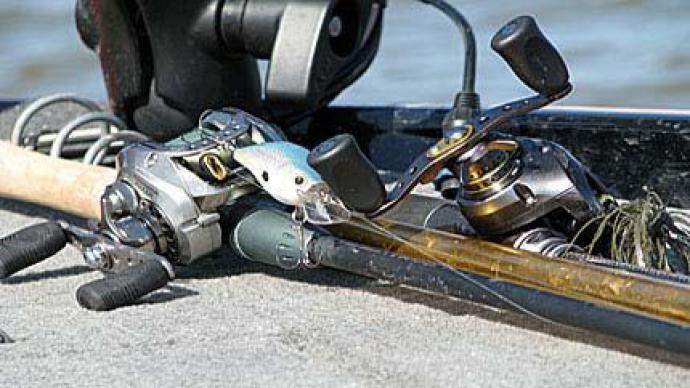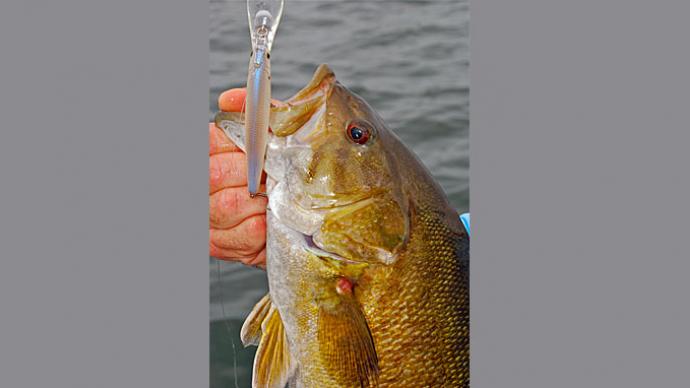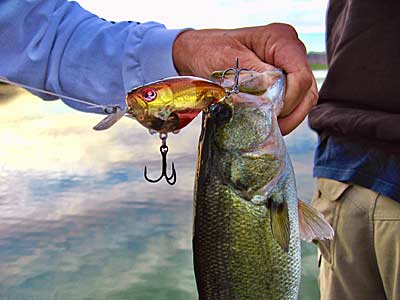
Because a crankbait is a reaction bait, you may think it's a warm-weather lure, but a plug will catch fish all year. Gary Dobyns says that even during the coldest weather, he looks for shallow fish first. The worst tournament he ever had was where he ignored his rule and fished a worm twenty-five feet deep the first half of the day. He did lousy until he switched to a reaction bait and fished in less than five feet of water.
Cranks For Banks
Justin Welch is an Arizona tournament fisherman who has made crankbaits his favorite lure and a hobby that is becoming a reasonably lucrative side hustle. He cranks all year and always tries to find a shallow pattern first, even on the coldest days. "The first thing I do is go to a point and look to see where the bait fish are," Welch says, "but if they're being chased on the bank, you won't see them on the graph." So he'll tie on a square bill like a Norman Fat Boy or a Strike King KVD 2.5 Wake Bait.
These are ideal baits for fan-casting to shore over a point – they've both got a good wobble and will go through or bounce off just about anything on the bottom without many snags. If Welch needs to go just a bit deeper, he'll switch to a Norman NXS, a bait that digs the bottom like a craw or baitfish but bounces up and off when it hits a snag. "I love the NXS because it gets down to depth quickly. That thing dives so fast it almost feels like you have a fish on! I’ve seen mine go down to 21 feet on the graph. This time of year (winter), I like shad colors and the Norman Canary."
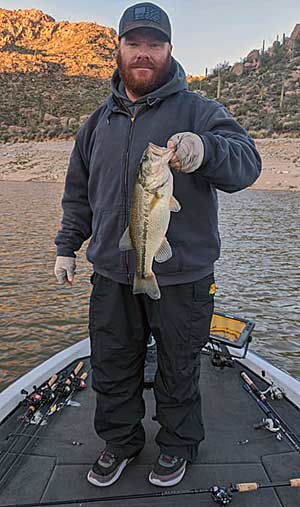
Justin likes to paint his lures, especially Norman DD22's and Norman Deep Little N's. Purple shad has been a killer color for him lately. “It’s a pretty basic color,” he says. “I usually prefer basic colors.” As the weather cools off, he likes a pretty good wobble in his baits, which he can get from specific wobbling lures and his square bills. “The Deep Little N isn’t crazy wide,” he says, “but it excels in winter, and so do flat-sided baits.”
Justin has been painting many baits lately. He gets the Norman blanks from Lurenet and uses his ever-increasing air-brushing gear to custom-color them. You can see his creations on Instagram @justinwelchfishing (and buy them, too). Another of his favorites is the Luhr Jensen Hot Lips – a phenomenal lure that most people forget, he says.
Cranking Gear
Justin uses Norman speed clips, which he attaches with a Palomar knot. The round split rings found on many crankbaits can get line stuck, and the speed clips eliminate that problem. Welch says that is more than just a way to change out lures quickly, though that is a big plus. In addition, the speed clips give more presentation to your bait. "It gives them more movement, like using a second split ring. I use them on everything, even frogs!" He says you can even make a popper or a frog walk with a speed clip.
He uses 12-pound-test Seaguar INVZX Fluorocarbon line for almost all of his crankbaits, and even though it hasn't got much stretch, good rods will take up the slack, so you don't have to worry about taking it away from the bass. In deep winter, he'll drop down to 10- or even 8-pound-test to get a couple more feet out of his baits.
For deep-diving baits like the Norman DD22's and NXS baits, he uses an 8-foot rod, but the rest of the time, he fishes cranks on a Dobyn's Kaden 735 CB crankbait rod. It's a 7'3" Medium/Heavy Moderate Fast rod. He likes his new Dobyns 805 Champion XP non-glass rod too. A powerful Diawa 5.5:1 reel finishes off his gear.
Deeper Movers And Shakers
Jerkbaits are great because they often move more than cranks, just because of how you fish them. Welch also likes the 5/8-ounce lipless Yo-Zuri Rattl’n Vibe crankbaits, especially the metallic ones like the Prism Tennessee Shad and the Metallic Bleeding Shad. From fall through late winter, he fishes these baits on rip rap and steeper banks, starting shallow and working deep. He says there's always a shallow bite, but he'll also catch them up to 25 or 30 feet deep, which is why he likes these baits – they start at the top and work their way down, picking up bass at every level. The Norman Fat Boy Square Bill is one of his favorites for structure.
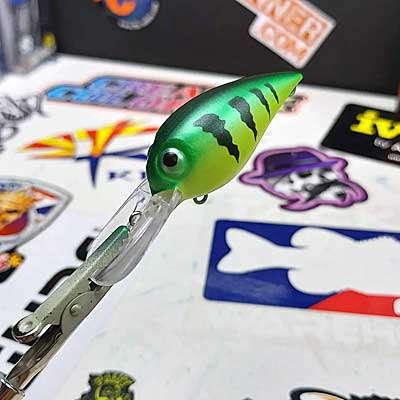
Sometimes he targets offshore structure in winter but still uses a bait that starts shallow and works its way down. A DD22 is ideal for this, as is a Deep Little N. If he finds trees on a hump in 15 to 20 feet of water, for instance, he'll circle the hump and make casts at it while paying particular attention to the angle of the cast when he gets a bite. The fish often want the bait coming at them in a particular direction. This can change with the time of day, so if you're making a milk run, you'll have to start over finding the right angle.
He'll do the same thing on a bank, working it in one direction, then turning around and working it the other way. If he still isn't getting bit, he'll try parallel. With rip rap, he has the most luck burning a bait down at about a 35-degree angle from the bank or even straight at it – 90 degrees. He'll go over a rip rap bank several times, then milk run it later and find out when they're pushing the baitfish up.
Welch likes rocks and says he doesn't waste time on "sand and stuff." Craw patterns like Norman's Fried Green Tomato or Ghost Pepper are great winter colors. The Ima Pinjack 200 is a perfect crankbait, he says – he likes Hot Shad and Hot Craw. It's a great winter bait, especially on cloudy days. It deflects off structure well. Another good cloudy day color is canary, and he's been painting a lot of those.
More Tips From Another Arizona Fisherman
Jerry Weston is another die-hard crankbait fisherman in Arizona who cranks pretty much all year, especially starting in the fall when the fish start eating and schooling. He takes the approach of finding the depth the fish are using, then choosing his crankbait based on that information. For instance, if the fish are at 10 feet, he'll choose a bait that will reach that depth or just above it since bass feed up. If the bass are hugging the bottom at ten feet, he'll choose a diver that will go 15 so it can "get bouncy." He uses 10- to 12-pound test line or even 8 on smaller baits. He might go as heavy as 15-pound fluorocarbon on a big, deep-diving lure. The fluorocarbon sinks a bit, so it helps get the divers down even deeper.
To alleviate the lack of line stretch, he chooses rods that aren’t too fast – he wants a parabolic action that will let the fish get it in their mouth before they feel it. A parabolic rod can counter the shock of that last surge the bass always seem to make – it works like a shock absorber, Jerry says. He likes composite rods with some glass and some sensitivity as well.
Tweaking Cranks
Jerry almost always changes out the hooks on a crankbait to Gamakatsu hooks, and he uses SuspenDots and SuspenStrips to get just about any crankbait to suspend when he stops it. SuspenDots are an ancient product that many anglers have forgotten, but they are amazing. You can wrap them around the hook, put some on the belly, and add all you want.
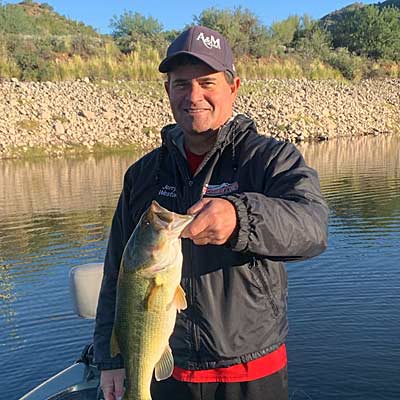
The trick is usually to add just enough weight to get the lure to hang in place when you stop cranking – and bass can't seem to resist that pause. Sometimes adding enough weight to make the lure rise slowly when stopped does the trick, too. You can also peel them off the lure later if you want to. If you have a swimming pool, it's easy to check the motion as you add the strips or dots.
Weston’s Got The Moves
Jerry never throws a crankbait out and cranks it back in. Instead, he uses the reel handle and does a reel-pause, reel-pause cadence to make the bait stop-and-go. A bait that suspends is ideal for this. He’ll also use a sweep-stop, sweep-stop motion using the rod to move the lure. This sweep-stop motion is killer with square bills in the brush.
Don't use the reel for this sweep; use the rod, he says, and tie directly to the bait, or use an oblong split ring that won't open up and slide over your line because the opening is on the side, not the end.
Best Baits
Jerry likes Berkley Dredgers with their round, deep-diver bills and the Berkley Wild Thang crankbaits with a square bill and stupendously erratic action. The Dredgers are smaller but still go as deep as bigger baits, and they come with great hooks – razor-sharp Fusion 19 trebles. Another of his favorites is the Rapala balsa baits. They’re silent, but they float up beautifully, so he likes them for the sweep-stop retrieve. His favorite colors are basic – shad and craw patterns. Shad for day and craw for night or clouds.
I've fished with both of these guys, and they are a couple of great sticks, especially when it comes to cranking. No matter what time of year it is or what the bass are doing, these guys can pull them out with a plug. And so can you!
BassResource may receive a portion of revenues if you make a purchase using a link above.


